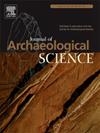粪便生物标记物作为Kraków-Częstochowa高地洞穴中人类存在的证据
IF 2.5
1区 地球科学
Q1 ANTHROPOLOGY
引用次数: 0
摘要
这项研究通过分析粪便生物标志物——特别是固醇、胆汁酸和磷——来调查过去人类在洞穴遗址的存在,并将结果与现有的考古数据进行比较。研究集中在Kraków-Częstochowa高地(波兰南部)的7个地点:Biśnik洞穴、Bramka Rockshelter、Ciasna洞穴、Łabajowa洞穴、Łokietka洞穴、Sąspowska Zachodnia洞穴和斯莫雷耶三世的避难所。它包括分析来自每个地点地层序列的沉积物样本。粪便生物标志物的应用使我们能够在几个不同的地层水平上检测人类粪便物质,与考古证据一致且独立于考古证据。我们的发现为该地区人类居住的现有考古数据做出了贡献,并揭示了粪便标记物存在和分布的独特模式。研究结果强调了针对更深洞穴区域的潜力,特别是旧石器时代的洞穴层,同时也确定了关键的局限性——最明显的是胆汁酸浓度低,这阻碍了解释,强调了对洞穴环境中影响生物标志物稳定性的因素进行进一步研究的必要性。本文章由计算机程序翻译,如有差异,请以英文原文为准。
Faecal biomarkers as evidence of human presence in the caves of Kraków-Częstochowa Upland
This study investigates past human presence at cave sites by analysing faecal biomarkers—specifically sterols, bile acids and phosphorus—and compares the results with available archaeological data. The research concentrates on seven sites in the Kraków-Częstochowa Upland (S Poland): Biśnik Cave, Bramka Rockshelter, Ciasna Cave, Łabajowa Cave, Łokietka Cave, Sąspowska Zachodnia Cave, and Shelter in Smoleń III. It involved analysing sediment samples from the stratigraphic sequences of each site. The application of faecal biomarkers allowed us to detect human faecal matter at several distinct stratigraphic levels, aligned with and independent of archaeological evidence. Our findings contributed to existing archaeological data on human occupation in the region and revealed distinct patterns in the presence and distribution of faecal markers. The results highlight the potential of targeting deeper cave areas, particularly Palaeolithic layers, while also identifying key limitations—most notably the low concentrations of bile acids, which hinder interpretation, highlighting the need for further research into the factors influencing biomarker stability in cave contexts.
求助全文
通过发布文献求助,成功后即可免费获取论文全文。
去求助
来源期刊

Journal of Archaeological Science
地学-地球科学综合
CiteScore
6.10
自引率
7.10%
发文量
112
审稿时长
49 days
期刊介绍:
The Journal of Archaeological Science is aimed at archaeologists and scientists with particular interests in advancing the development and application of scientific techniques and methodologies to all areas of archaeology. This established monthly journal publishes focus articles, original research papers and major review articles, of wide archaeological significance. The journal provides an international forum for archaeologists and scientists from widely different scientific backgrounds who share a common interest in developing and applying scientific methods to inform major debates through improving the quality and reliability of scientific information derived from archaeological research.
 求助内容:
求助内容: 应助结果提醒方式:
应助结果提醒方式:


